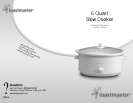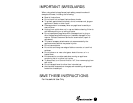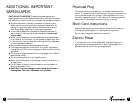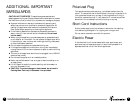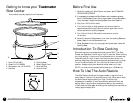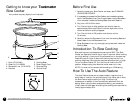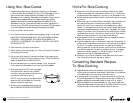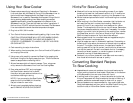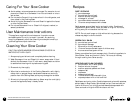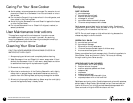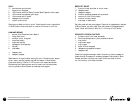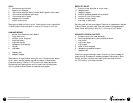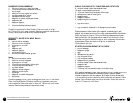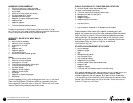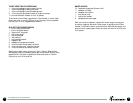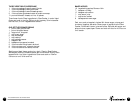
7.
6.
Using Your Slow Cooker
1. Prepare recipe according to instructions. Place food in Stoneware
Liner and cover with the Glass Lid. Do not fill the Stoneware Liner to
the brim with food. Always cook with the Glass Lid on and the
Stoneware Liner in position. Remember that frequent lifting of the lid
during cooking delays cooking time. When cooking a meat and
vegetable combination, place the vegetables in the bottom of the
Stoneware Liner first. Then add the meat and other ingredients. If
the liner is hot, DO NOT add cold food and vice versa. The Stoneware
Liner cannot stand the shock of sudden temperature changes.
2. Plug into a 120 V, 60 Hz outlet.
3. Turn Control Knob to the desired cooking setting, High, Low or Auto.
CAUTION: COOKING BASE WILL GET VERY WARM DURING
COOKING. THIS IS WHERE THE HEATING ELEMENT IS
LOCATED. IF NECESSARY TO HANDLE, USE POT HOLDERS
OR OVEN MITTS.
4. Cook according to recipe instructions.
5. When cooking time is complete, turn Control Knob to Off position
and unplug from outlet.
6. Using oven mitts, carefully remove the Glass Lid by grasping the
Knob and lifting the lid slightly away from you. This will allow the
steam to escape before removing the lid.
7. Allow a few seconds for all steam to escape. Then, using oven
mitts, remove the Stoneware Liner from the Cooking Base.
8. Even when switched OFF, and unplugged,
the Slow Cooker remains hot for some
time after using; set aside and allow unit to
cool before cleaning or storing.
NOTE: If you are moving the Slow Cooker,
grasp the unit by the Base Unit Handles;
use pot holders or oven mitts.
9. Allow to cool completely before cleaning,
see CLEANING YOUR SLOW COOKER.
Hints For Slow Cooking
◆ Meats will not brown during the cooking process. If you desire
browning the meat first, heat a small amount of oil in a skillet on
the stove and brown meats prior to putting into Stoneware Liner.
◆ Whole herbs and spices flavor better in slow cooking than crushed
or ground.
◆ When cooking in the Slow Cooker, remember that liquids do not
boil away like they do in conventional cooking. Reduce the
amount of liquid in any recipe that is not designed for a Slow
Cooker. The exceptions to this rule are rice and soups. Remember,
liquids can always be added at a later time if necessary. If a recipe
results in too much liquid at the end of the cooking time, remove
the Glass Cover and turn the Control Knob to High. After about
30-45 minutes the amount of liquid should be reduced.
◆ Most recipes that call for uncooked meat and vegetables require
about 6-8 hours on Low temperature.
◆ High fat meats can result in dishes with less flavor. Pre-cooking or
browning will help reduce the amount of fat and help to preserve
the color. The higher the fat content, the less liquid needed. If
cooking meat with a high fat content, use thick onion slices under
it so that the meat will not set in and absorb the fat. If necessary,
use a slice of bread, a spoon, or a straining spoon to skim off
excess fat from top of foods before serving.
◆ Foods cut into uniform pieces will cook faster and more evenly
than foods left whole such as roast or poultry.
Converting Standard Recipes
To Slow Cooking
◆ Vegetables such as carrots, potatoes, turnips, and beets require
longer cooking times than most meats. Place them on the bottom
of the Stoneware Liner and cover them with liquid.
◆ If adding fresh milk or yogurt, it should be done during the last
2 hours. Evaporated milk may be added at the start of cooking. If
possible, substitute condensed soups for fresh milk or yogurt.
◆ Rice and pasta are not recommended for long cooking periods.
Cook them separately and then add to the Slow Cooker during the
last 30 minutes, or follow Slow Cooker recipe directions.
6 Quart Slow Cooker Use and Care Guide



